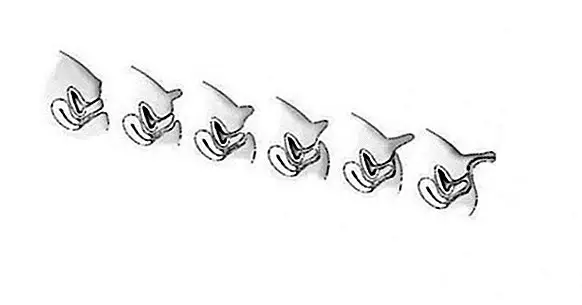Güevedoces: people who change sex at puberty?
The process of development of the fetus in the uterus of the mother encloses a whole network of chemical and organic reactions that enable the evolution of the baby. But this development, which works like a perfect machine, is sometimes altered, causing all kinds of organic anomalies.
This is the case of guevedoces, a very common phenomenon in the Dominican Republic in which some girls, upon entering puberty, suffer a kind of natural sex change.
- Related article: "Gender stereotypes: this way they reproduce inequality"
Who are the guevedoces?
Güevedoces is an appellation given to a series of people from the Dominican Republic born with a chromosomal alteration imperceptible at the moment of birth that causes the following phenomenon: babies born with the appearance of ambiguous genitalia, and to those who are usually assigned to the female sex, who undergo a process of masculinization at puberty.
These people really have male chromosomes (XY). But nevertheless, during fetal development they grow up developing a genital ambiguity . At the time of birth, they tend to be assigned as female sex and at puberty, at about 12 years of age, there is a growth of the penis and the descent of the testicles.
Furthermore, if there is one thing that makes this phenomenon even more fascinating, it happens almost negligibly all over the world but, nevertheless, in the province of Barahona, in the Dominican Republic, appears in approximately 1 out of every 50 births in which it is determined that the sex of the baby is female. Due to this huge number of cases, if the incidence of this condition in the world population is taken into account, children born with these characteristics are given the name of guevedoces.
A type of pseudointersexuality
This genital alteration, considered as a type of male pseudointersexuality , was described for the first time in the Dominican Republic, the 70s of the last century by the American doctor and endocrinologist Julianne Imperato-McGinley. Following studies and research of people with these characteristics, it was determined that the guevedoces suffered a deficiency of the enzyme 5-alpha reductase.
The deficit of this enzyme causes a physical alteration known as hereditary male pseudointersexuality. Adequate levels of this enzyme result essential for testosterone to be converted to dihitestosterone If this does not occur due to a lack of 5-alpha reductase, the masculinization of the external genitalia during fetal development can not be carried out.
In the specific case of guevedoces, the increase of testosterone levels during puberty generates a response in the body, causing the growth of the penis and the descent of the testicles.
- You may be interested: "What is intersexuality? Definition, causes and types
How do they develop physically?
Usually, during the development of the first weeks of pregnancy andThe fetus does not have any specification regarding sex organs , only the nipples develop in both sexes. Then, at approximately eight weeks of gestation, the sex hormones intervene again.
Birth and childhood
If the baby is genetically determined as a male sex, the Y chromosome makes sure that the gonads are transformed into testicles sending testosterone to the tuber, where it becomes the hormone dihitestosterone. Which, as we have mentioned previously, makes possible the masculinization of the sexual organs and converts the tubercle into the penis.
In the case of having chromosomes corresponding to the female sex, the synthesis of dihydrosterone does not take place and the tuber becomes then a clitoris.
However, in people known as guevedoces, in whom this type of pseudointersexuality appears, the symptoms are limited to the appearance of the external genitalia, which appear phenotypically as feminine . On some occasions before reaching puberty, there is a small penis that can be perceived as a clitoris, a bifid scrotum and an urogenital sinus open in the perineum.
The testicles are usually located hidden in the inguinal canal or in the labio-scrotal folds, while the internal structures derived from the Wolf's duct (epididymis, vas deferens and seminal vesicles) develop without any type of anomaly.
Puberty
With the passage of time and the arrival of puberty, as with all young people, the person experiences a large exposure to endogenous testosterone . That is, testosterone that our own body produces. This produces a masculinization of both the physical features of the person, and of the genitals in the case of the guevedoces.
This masculinization, in addition to the usual occurrence of severe voice, an increase in muscle mass, in people with a male hereditary pseudointersexuality of this type also causes the growth of the penis and the decrease and increase in the size of the testicles. Further, no type of breast development is manifested similar to the feminine.
In contrast, in most cases typically male facial hair is barely visible and the size of the prostate is significantly lower compared to the average.
As a result of the study of cases, it has been possible to determine that guevedoces people experience erections with all normality, being able to have sexual intercourse with complete penetration, but without the capacity to inseminate due to the disposition of the urethra.
The results of the Imperato-McGinley study
After years of studying the guevedoces, Dr. Imperato-McGinley discovered that in most cases people They manifest identify with their male sex and with a heterosexual orientation , despite having been raised as girls, and decide to conserve male genitalia.
However, on other occasions the person feels part of the female gender, so it is common for some of them to undergo a sex-change operation that gives them female genitals.
As a result of this, the doctor and her team concluded that when adopting a sexual and gender identity, the influence of hormones is stronger than the conditioning factors of education .
Regardless of one case or another, in most cases the appearance of male genitalia is an impact for the person, which may experience a series of crisis in their identity, as this causes a change in the gender role of the person.
Finally, although this phenomenon is relatively common in this area of the Dominican Republic, guevedoces are often repudiated in society, being victims of a part of the population that does not accept them. This carries a risk of marginalization and social isolation.



















